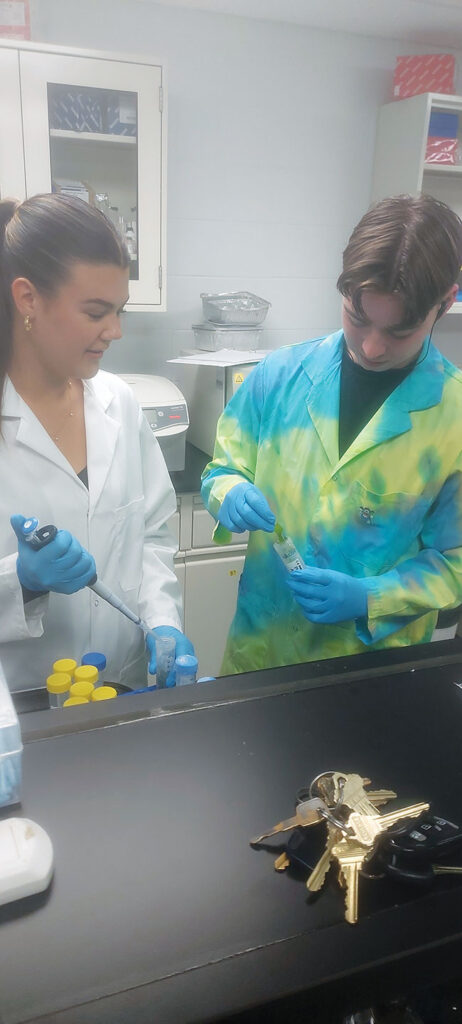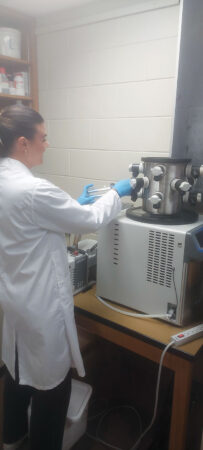
Features
Diseases
New diagnostic tool for soybean stem and root diseases
Field-ready diagnostic tool provides early, accurate and rapid detection of multiple soybean diseases simultaneously.
February 7, 2024 By Donna Fleury
 Ben Pilling and Milah Mikkelsen processing soybean samples for the diagnostic tool in the lab at Brandon University.
PhotoS courtesy oF Brandon University.
Ben Pilling and Milah Mikkelsen processing soybean samples for the diagnostic tool in the lab at Brandon University.
PhotoS courtesy oF Brandon University. Soybeans are an economically important crop in Manitoba and the third-largest crop seeded in the province. However, growers can be challenged with multiple root and stem diseases that impact plant growth, survival and harvesting yields. Early detection of the most severe and prevalent stem and root diseases in soybean is critical for disease control and management.
“Growers and industry have generally relied on annual disease surveys and visual assessments of symptom development,” says Bryan Cassone, chair and professor of biology at Brandon University. “However, disease diagnosis can be challenging, and soybeans are often infected by multiple diseases at the same time, compounding proper disease identification. In a recent three-year pilot study, our results indicated that less than 25 per cent of these visual identifications were accurate, and identification of co-infections was almost impossible. Although there are molecular methods already available for some soybean pathogens, the testing is currently limited to testing one specific pathogen at a time. This highlights the need for improved techniques and the development of diagnostic tools that can quickly and accurately identify multiple emerging diseases simultaneously.”
Cassone is completing a three-year project to develop a diagnostic tool that can simultaneously detect which pathogens are causing diseases in soybean fields. The goal of the project is to develop a tool that can catalog the diseases present and their abundance, accurately determining multiple important diseases at the same time. The project focused on four of the most common and economically important fungal and oomycete pathogens in infected soybean stem and root diseases: root/stem rot (Phytophthora sojae), white mold (Sclerotinia sclerotiorum), pod/stem blight (Diaporthe phaseolorum) and fusarium root/stem rot (Fusarium oxysporum).
“We first developed the molecular diagnostic tool in the lab and tested it by inoculating soybeans with known stem and root pathogens to determine whether the tool could identify single and co-infections in the developing plants,” explains Cassone. “Using molecular biology tools, DNA profiles were developed for each of the pathogens. We developed multiplex assays that allow us to test for multiple pathogens in a given sample. These assays can detect and quantify up to four stem and root pathogens simultaneously. Once we had success in the lab, we validated the results using commercial field samples collected directly from Manitoba soybean fields at various growth stages over two years.”

Milah Mikkelsen processing soybean samples for the diagnostic tool in the lab at Brandon University.
This innovative diagnostic tool improves the accuracy of testing, is rapid and cost-effective. The time between tissue sample collection and diagnoses is fairly quick, and testing can be completed in less than a day. For growers, one of the useful aspects of the tool is it can accurately detect the pathogens throughout the growing season, even prior to the development of disease symptoms. Cassone notes that if growers have been impacted by diseases in previous years or are worried about potential risks, this tool can help determine if the disease is in their crop before it becomes problematic. Early detection will help inform disease management and control strategies.
“Now that the development of the diagnostic tool for multiple soybean stem and root diseases is completed, the next steps are to determine the best commercialization strategy for making the tool available,” says Cassone. “Most testing labs with molecular testing capabilities will be able to provide the testing services. The test methods are developed but have not yet been published. Our goal is to make this much-improved soybean diagnostic tool widely available. We also want this tool to be used more broadly, and so far, the samples we have run from other locations in Canada and the U.S., such as Ohio, another large soybean-producing area, have been successful. We plan to investigate other places more thoroughly in the U.S. and other soybean-growing locations around the world to see if this holds true. Since we can now detect multiple diseases simultaneously, we also hope to see additional research focused on the co-infection impacts of these diseases taken together on soybean crop growth, survival and harvesting yields in the future.”
Once commercialization plans have been implemented, this soybean disease diagnostic tool can be incorporated into annual provincial disease surveillance programs. Growers will also be able to send their early-season tissue samples and diseased soybean samples to a diagnostic lab for testing. Early detection of the most severe and prevalent stem and root diseases in soybean is critical for disease management and the selection of appropriate control measures in the field. This new diagnostic tool for multiple soybean diseases is a significant improvement on current tools and is expected to be widely available once commercialized.